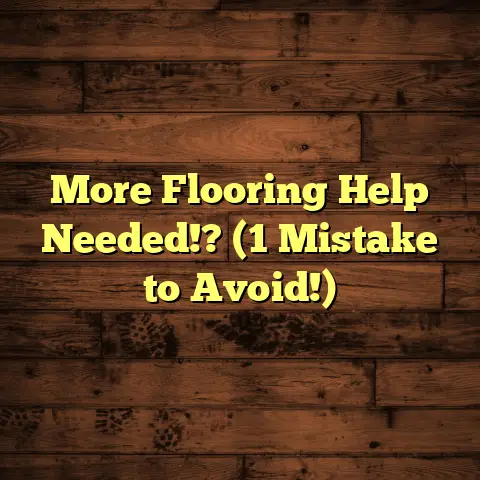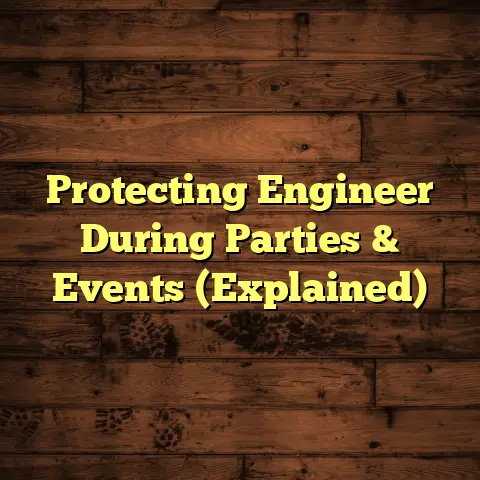Asbestos In Laminate? Know This! (5 Min. Read!)
But, have you ever stopped to wonder about what’s
actually in that flooring?
Let’s dive into a topic
that might make you rethink that beautiful surface:
asbestos in laminate.
I’ve been in the flooring business for over 20 years,
and I’ve seen firsthand the good, the bad, and the
sometimes downright scary when it comes to flooring.
So, grab a coffee, and let’s get into it.
Laminate Flooring Myths Busted
Before we deep-dive into the asbestos issue, let’s
clear up some misconceptions about laminate.
I
hear these all the time:
“Laminate flooring lasts forever.” Nope.
While it’s durable, it’s not invincible.
Think of it like this: a good quality laminate, with proper care, might last 10-20 years.
Hardwood, on the other hand, if properly maintained, could last a lifetime.“Laminate is completely waterproof.” Big myth!
Laminate is water-resistant, not waterproof.
A quick spill?
Wipe it up.
A flood?
You’re in trouble.
I’ve seen too many laminate floors buckle and warp from water damage to believe this one.“All laminate flooring is the same quality.” Absolutely not.
You get what you pay for.
The thickness of the wear layer, the density of the core board – these things matter.
Cheap laminate will scratch easily, and it won’t hold up to heavy use.
I’ve seen the difference between a $1 per square foot laminate vs a $4 laminate, and trust me, it’s night and day.“Laminate flooring can withstand heavy furniture and high foot traffic without damage.” It can handle a reasonable amount, but heavy furniture without proper protection (like felt pads) will dent it.
And high heels?
They’re laminate’s worst enemy.
I’ve seen floors completely destroyed by stiletto heels.
Section 1: Understanding Laminate Flooring
So, what is laminate flooring anyway?
Laminate is a multi-layer synthetic flooring product
fused together through a lamination process.
Think of it as a high-tech sandwich.
Here’s what you’ll typically find:
Backing Layer: This is the foundation.
It’s usually a moisture-resistant layer that provides stability and prevents warping.Core Layer: This is the main body of the laminate.
It’s typically made of high-density fiberboard (HDF) or medium-density fiberboard (MDF).
This layer provides the flooring’s strength and impact resistance.Design Layer: This is where the magic happens.
It’s a photographic image of wood, stone, or whatever pattern you desire.
High-resolution printing technology makes these images incredibly realistic.Wear Layer: This is the top layer, and it’s the workhorse of the whole operation.
It’s a transparent, protective layer that resists scratches, stains, and fading.
The thicker the wear layer, the more durable the flooring.
How It’s Made
The manufacturing process involves pressing these
layers together under high heat and pressure.
This creates a durable, stable, and visually
appealing flooring product.
Unlike solid hardwood, which is a single piece of wood, or engineered wood, which has a layer of real wood on top, laminate is entirely synthetic.
The Upsides
Laminate has a lot going for it:
- Easy Installation: Many laminate floors feature a click-lock system, making them relatively easy to install yourself.
- Low Maintenance: Just sweep and mop. No need for waxing or refinishing.
- Affordability: Laminate is generally less expensive than hardwood or tile.
But remember those myths we busted?
There are
limitations.
And that brings us to the darker side
of the story: asbestos.
Section 2: The Asbestos Connection
Let’s talk about asbestos.
It was once considered a
wonder material.
It’s naturally occurring, heat-
resistant, strong, and flexible.
For much of the
20th century, it was used in everything from
insulation to brake pads to… you guessed it,
flooring.
Asbestos in Flooring: A History
In the mid-20th century, asbestos was added to
some flooring products to increase their durability,
fire resistance, and flexibility.
Think of it as
a binder or a strengthener.
This was especially common in:
- Vinyl floor tiles: These were often 9×9 inch tiles, and the asbestos was mixed into the vinyl.
- Sheet vinyl flooring: Similar to the tiles, asbestos could be in the backing of the sheet.
- Adhesives: The glue used to install flooring sometimes contained asbestos.
Laminate and Asbestos: The Link
So, where does laminate fit in?
Well, it’s not
as common as in vinyl, but asbestos could be
present in older laminate flooring, particularly
in the backing layer or in the adhesive used to
install it.
Why?
Because laminate flooring gained popularity
later than vinyl.
However, if your home was built
or renovated before the 1980s, and it has laminate
flooring, it’s worth considering the possibility.
Regulations Over Time
The dangers of asbestos became increasingly clear
throughout the 1970s, and regulations started to
tighten.
The EPA banned many uses of asbestos in
the late 1980s, but some products were still allowed
to contain it.
It wasn’t until more recent years
that we’ve seen more comprehensive bans and
restrictions.
The Risks
Asbestos exposure is linked to serious health problems:
- Mesothelioma: A rare and aggressive cancer that affects the lining of the lungs, abdomen, or heart.
- Lung Cancer: Asbestos exposure significantly increases the risk of lung cancer, especially in smokers.
- Asbestosis: A chronic lung disease that causes scarring and shortness of breath.
These diseases can take decades to develop after exposure, which is why it’s so important to be aware of the risks and take precautions.
Section 3: Identifying Asbestos in Laminate Flooring
Okay, so you’re wondering if your laminate floor
might contain asbestos.
Here’s how to approach it:
Visual Cues
- Age of the Flooring: If your flooring was installed before the 1980s, it’s more likely to contain asbestos.
- Brand Names: Some manufacturers were known
to use asbestos in their flooring.
Researching the brand and model of your flooring might provide clues. - Appearance: Asbestos-containing flooring often has a dull, grayish appearance.
Important: Don’t start tearing up your floor based on these cues alone! Disturbing asbestos materials can release fibers into the air, which is what you want to avoid.
Professional Testing
The only way to know for sure if your flooring
contains asbestos is to have it tested by a
certified professional.
Here’s what that involves:
- Inspection: A qualified inspector will assess your flooring and take samples.
- Sampling: They’ll carefully collect small samples of the flooring material.
- Lab Analysis: The samples are sent to a laboratory for analysis.
- Report: You’ll receive a report detailing whether or not asbestos was detected.
Finding a Professional
Look for companies that are licensed and certified
to perform asbestos inspections and testing.
Ask for references and check their credentials.
Real-Life Scenarios
I remember one client, Mrs. Davis, who called me
in a panic.
She was renovating her kitchen and
started pulling up her old laminate floor when she
noticed a grayish layer underneath.
She had a hunch
it might be asbestos, and she was right.
We stopped
the renovation immediately, had the flooring tested,
and brought in an abatement team to safely remove
the asbestos-containing materials.
It was a stressful
situation, but we were able to handle it safely and
professionally.
Section 4: Health Risks and Safety Precautions
Let’s be clear: asbestos exposure is not something to take lightly.
The Health Risks, Revisited
I mentioned mesothelioma, lung cancer, and
asbestosis earlier.
These are all serious, life-
threatening diseases.
The risk of developing these
conditions depends on several factors, including:
- Duration of Exposure: The longer you’re exposed, the higher the risk.
- Intensity of Exposure: The more asbestos fibers you inhale, the greater the risk.
- Type of Asbestos: Some types of asbestos are more dangerous than others.
- Individual Factors: Smoking, genetics, and other health conditions can also play a role.
Personal Protective Equipment (PPE)
If you suspect you might be dealing with asbestos-
containing materials, do not attempt to remove
them yourself without proper PPE.
This includes:
- Respirator: An N-95 or P-100 respirator is essential to filter out asbestos fibers.
- Protective Clothing: Wear disposable coveralls to prevent asbestos fibers from clinging to your clothing.
- Gloves: Use disposable gloves to protect your hands.
- Eye Protection: Wear safety glasses or goggles to prevent asbestos fibers from getting into your eyes.
Professional Remediation
If testing confirms the presence of asbestos, the
best course of action is to hire a professional
asbestos abatement company.
These companies have
the training, equipment, and expertise to safely
remove and dispose of asbestos-containing materials.
Here’s what they’ll typically do:
- Containment: They’ll seal off the work area to prevent asbestos fibers from spreading.
- Wetting: They’ll wet the asbestos-containing materials to minimize the release of fibers.
- Removal: They’ll carefully remove the materials and seal them in airtight containers.
- Disposal: They’ll transport the containers to a designated disposal site.
- Clearance Testing: After the removal, they’ll conduct air monitoring to ensure that the area is safe.
The Psychological Impact
Finding asbestos in your home can be incredibly
stressful.
It’s natural to feel anxious, worried,
and even scared.
It’s important to stay informed,
seek support from friends and family, and consult
with professionals who can guide you through the
process.
Section 5: Alternatives to Asbestos-Containing Laminate
The good news is that modern laminate flooring is
asbestos-free.
And there are plenty of other great
flooring options to choose from:
Modern Laminate
Today’s laminate flooring is made with safer
materials and offers a wide range of styles and
colors.
Look for products that are certified by
organizations like FloorScore, which ensures that
they meet strict indoor air quality standards.
Eco-Friendly Options
- Bamboo: A sustainable and renewable resource that’s durable and stylish.
- Cork: A naturally resilient and comfortable flooring option that’s also eco-friendly.
Luxury Vinyl Tile (LVT)
LVT is a popular choice for its durability, water
resistance, and realistic wood or stone look.
It’s also available in a wide range of styles and
colors.
Advancements in Technology
Flooring technology has come a long way in recent
years.
Manufacturers are constantly developing new
materials and techniques to create flooring that’s
more durable, sustainable, and beautiful.
Conclusion
Let’s recap.
Asbestos in laminate flooring is a
real concern, especially in older homes.
While
modern laminate is generally safe, it’s important
to be aware of the potential risks and take
precautions if you suspect your flooring might
contain asbestos.
Key Takeaways:
- Know the signs of asbestos-containing flooring.
- Don’t disturb suspected materials without proper PPE.
- Get your flooring tested by a certified professional.
- If asbestos is present, hire a qualified abatement company.
- Explore modern, asbestos-free flooring options.
I urge you to take proactive steps to evaluate
your flooring and protect your health.
If you’re
unsure about anything, seek professional help.
Have you had experience with asbestos in your home?
Share your story in the comments below.
Your
experiences can help others stay informed and safe.
Stay safe, and happy flooring!





